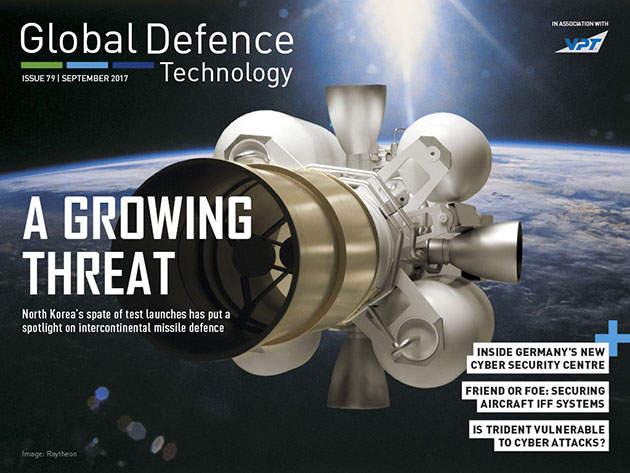

Recent missile tests by North Korea have instilled urgency in the race to perfect missile interception systems capable of taking down an intercontinental missile in flight. We take a look at technologies in development to find whether effective interception can be achieved, and what it would mean for the global security picture.
We also take a look at the Netherlands’ defence procurement strategy, hear about the Germany military’s new cybersecurity research centre, and speak to lawyers involved in drafting a manual setting out the legalities of warfare in outer space.
Plus, we look at technologies being developed to provide secure identification friend-or-foe equipment for aircraft, investigate cybersecurity concerns surrounding the UK’s Trident nuclear deterrent system, and hear about the challenges of naval construction logistics.
In this issue
Securing basic readiness
The Netherlands’ defence spending is forecast to grow, fuelled by a need to modernise capabilities across the board and meet NATO commitments. Dr Gareth Evans takes a look inside the Dutch military strategy
Read the article.
Cracking the CODE
Many of the world’s armed forces are increasingly taking cybersecurity seriously, not least of all Germany. Lucy Ingham hears from Dr Gabi Dreo Rodosek, director of the newly established cybersecurity research centre CODE at the University of Federal Armed Forces Munich, about the challenges that lie ahead.
Read the article.
How well do you really know your competitors?
Access the most comprehensive Company Profiles on the market, powered by GlobalData. Save hours of research. Gain competitive edge.

Thank you!
Your download email will arrive shortly
Not ready to buy yet? Download a free sample
We are confident about the unique quality of our Company Profiles. However, we want you to make the most beneficial decision for your business, so we offer a free sample that you can download by submitting the below form
By GlobalDataHorse and Hound
Animals have played a part in military activity for centuries and still play a major role today, be it in ceremonial roles or on the front line. Claire Apthorp finds out who takes care of the military animals, and how has their job changed over the years?
Read the article.
Intercepting intercontinental missiles
Intercepting an intercontinental ballistic missile in flight has often been described as hitting a bullet with a bullet, and it makes for a pretty accurate analogy. Dr Gareth Evans asks whether it can be done.
Read the article.
Friend or Foe?
The US Air Force has contracted Raytheon to provide secure identification friend-or-foe (IFF) equipment in a bid to help safeguard aircraft. Claire Apthorp takes a look at Raytheon’s solution and other approaches to keeping IFF equipment secure.
Read the article.
New Rules for Space Warfare
An international coalition of lawyers is set to draft a manual setting out the legalities of warfare in outer space. Claire Apthorp speaks to lawyers from the University of Exeter’s Law School who are working on the project
Read the article.
How Vulnerable is Trident?
A report released earlier this year suggests that there are major vulnerabilities that could be exploited by hackers to render the UK’s nuclear missile equipped Trident submarines useless, or worse. Could that be true, and if so what can be done? Dr Gareth Evans reports.
Read the article.
Meeting Supply Chain Challenges
In this case study looking at the construction of HMS Queen Elizabeth, Chris Fenton, managing director of industrial and transport at Wincanton, highlights the importance of collaboration in the naval shipbuilding supply chain
Read the article.
Next issue preview
In the 2018 US budget speech Congress was urged to implement the 2010 Palau Compact Review Agreement – a package of financial support in exchange for military advantage. We take a look at the military history between the US and Palau and ask what advantage continued cooperation will provide in the Western Pacific.
Marinebedrijf Koninklijke Marine is scanning the entire Dutch naval fleet, aiming to use the data to create replacement parts using 3D printing techniques in the future. We find out more about this approach to naval maintenance. We also review new developments in soldier armour, check in on progress of the UK’s Type 26 frigate programme, and take a look at a new partnership agreement between the UK, the US and Norway to work together on anti-submarine warfare in the North Atlantic using jointly acquired P-8 aircraft.
Digital magazine FAQ
You can read Global Defence Technology for free on the iPad. Download our app from the App Store to read the latest issue and browse the back issues in our archive.
You can also continue to read the desktop version for free on our web viewer. (Browser compatibility: The web viewer works in the latest two version of Chrome, Firefox and Safari, as well as in Internet Explorer 9 and 10. Some features may not be compatible with older browser versions.)
Sign up for a free subscription to receive an email notification when a new issue is available.



